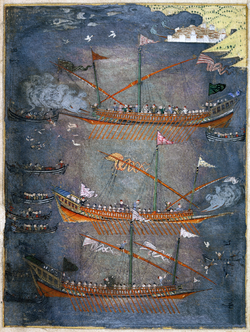Polish-Ottoman War (1633-1634)
| Polish–Ottoman War 1633–1634 | |||||||||
|---|---|---|---|---|---|---|---|---|---|
| Part of Polish–Ottoman Wars | |||||||||
 Allied Zaporozhian Cossacks in chaika boats attacking Turkish galleys in the Black Sea, 1636 |
|||||||||
|
|||||||||
| Belligerents | |||||||||
|
|
|
||||||||
| Commanders and leaders | |||||||||
|
|
|
||||||||
The Polish-Ottoman War of 1633–1634 refers to one of the many military conflicts between the mighty united Crown of the Kingdom of Poland and the Grand Duchy of Lithuania (Polish-Lithuanian Commonwealth), the Ottoman Empire and its vassals.
Mehmed Abazy was the governor of the Ottoman province of Sylistria (Silistra, today in Bulgaria). In 1632, after the death of the Polish king Sigismund III Vasa, the Tsardom of Russia broke an armistice and started a war with the Commonwealth (Smolensk War 1632–1634). Abazy mobilized his troops and called Moldavian, Wallachian and Nogai Tatar (of the Budjak Horde) as reinforcements. Abazy was ambitious and possibly acted without the sultan's or the grand vizier's knowledge as the Ottoman Empire was deeply involved with a war against the Safavids (1623–1639). The sultan claimed ignorance of Abazy's actions but it's possible that sultan Murad IV secretly agreed to the risky campaign against the mighty Commonwealth.
Around June 29, 1633 a strong Tatar group of Budjak Horde (about 1,000 strong) raided the area near the city of Kamieniec Podolski. This raid ended and the Tatars returned to Moldavia with their loot and jasyr. Meanwhile, the Commonwealth commander, Hetman Stanisław Koniecpolski was in Bar and moved immediately in pursuit with 2,000 cavalry when the news reached him. The hetman crossed Dniestr river and entered the Ottoman-controlled territory of Moldavia, which had been the theatre of the previous Commonwealth-Ottoman war just a few decades earlier (the Moldavian Magnate Wars). The Tatars probably thought they were safe and slowed down thus allowing hetman to catch with them on July 4 near Sasowy Róg at river Prut. Several dozens of Tatars were killed and captured, the rest dispersed. Among captives were several high ranking Tatars and Khan Temir's son in law (Khan Temir, Kantymir – chief of Budjak Horde, a well known and ferocious Nogai Tatar leader). Most of loot, all captives, cattle and horses were recovered.
...
Wikipedia
